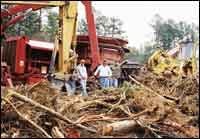When Georgia enacted a ban on outdoor burning several years ago, Chuck Conkle recognized an opportunity. "The ban meant that trees and brush cleared from construction sites and highway rights-of-way couldn't be burned between the months of May and October," says Conkle. "The most cost-effective way to handle these materials is to grind them up for disposal or recycling. I saw that as an avenue for a new business."
Conkle purchased its first tub grinder in 1997, and the business has grown steadily ever since; two more tub grinders were added the next year, and a fourth was added in 1999.
The company's primary clients are land-clearing and grading contractors. Eighty-five percent of its work is repeat business or referrals from clients. Conkle's four Morbark 1300 tub grinders process tree limbs, branches, and stumps and vegetation into usable mulch. Processed material either is spread on the site for erosion control or hauled away.
"With our 1,000-hp tub grinders, we can process 400 cubic yards of material per hour, including large tree limbs and stumps," says Conkle. "They have 13-foot tubs mounted on semi-trailers. The lowest part of the bowls have 10 foot-6 inch openings; they will grind up anything that will fit in the bowl."
Other equipment includes four Caterpillar 963C track loaders, three Cat 320CL 47,000-pound excavators, and one Cat 325C 60,000-pound excavator. Mack tractors transport grinders around jobsites. A service truck, stocked with tools, replacement parts, fluids, and other items needed for regular maintenance, goes on the job with each tub unit.
"Each machine has a crew of three," says Conkle. "One operates the grinder with built-in grapple for loading material into the tub; one runs a wood shear attachment that replaces the bucket of an excavator to cut tree parts into smaller pieces for easier loading into the tub; and the third operates a loader to push debris within reach of the grapple."
Conkle owns all of its equipment. "I strongly believe it is best to own equipment," he says. "We control the hours machines are operated, when to trade on a new machine—there are no restrictions as you have with leasing. We answer to no one about the equipment decisions we make."
The first consideration in choosing equipment is durability, he says. Another important factor is product support. Tub-grinder support comes directly from the factory with Morbark personnel coming to Conkle's service facility, whenever necessary.
"I am a very hands-on guy when it comes to maintenance," Conkle says. "I know this equipment very well. I am 100-percent involved, because if a machine isn't fixed right, it is not going to hold up, and we simply cannot afford downtime."
Conkle has a service contract with its Atlanta dealer, Yancey Bros. Dealer personnel service machines on-site at prescribed intervals. The dealer performs fluid analysis to identify potential problems before trouble occurs.
During the off season, equipment is reconditioned at Conkle's in-house shop. Tub grinders are traded in on new equipment every 3 years. Cat equipment is turned every five years.
"The options are making payments on new equipment or paying for parts and repair bills, and there comes a point when old equipment begins to cause downtime, and downtime does not generate income."
Conkle expects continued growth, but cautions that growth must be controlled. "Growing pains can kill a company," he says. "We've been very successful and profitable, but there always are avenues for improvement, and we will continue to search for them. And if the burn ban is extended throughout the year, we'll have to gear up to meet increased demands."





